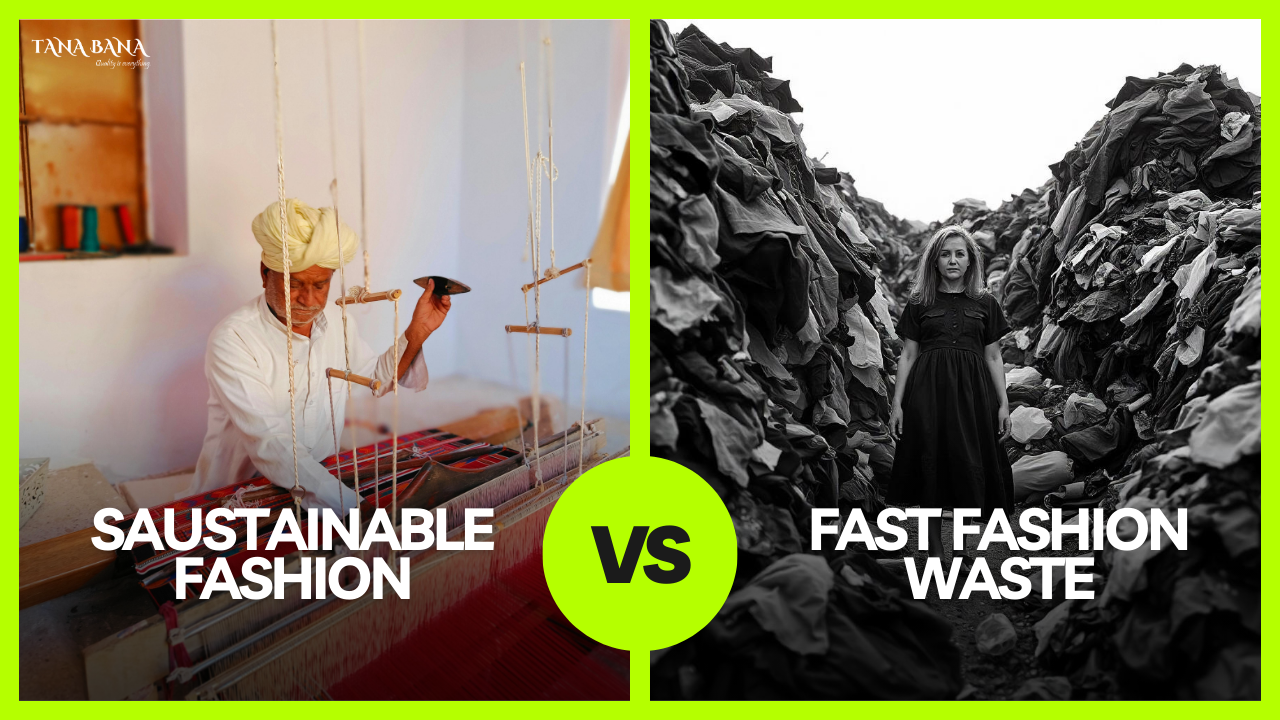Blog Details
Landfills and Fashion: The Hidden Truth Beneath Our Clothes

RAVI | November 27, 2024
When you toss an old T-shirt or a worn-out pair of jeans into the trash, have you ever wondered where it ends up? The reality is shocking: 92 million tons of textile waste are generated annually worldwide, with the majority of it finding a permanent home in overflowing landfills. The culprit? Fast fashion. But there’s a beacon of hope: conscious brands like Tana Bana, weaving sustainability into every thread.
Fast Fashion: A Time Bomb for Landfills
The fast fashion industry thrives on quick turnovers, offering cheap, trendy clothing that’s discarded just as quickly. Synthetic fibers, which make up more than 65% of global textiles, are non-biodegradable and linger in landfills for 200+ years, leaching harmful chemicals into the soil and water.
- Stat Alert: A study by the Ellen MacArthur Foundation reveals that by 2030, the equivalent of 12 million garbage trucks of clothes will be discarded annually.
The Bigger Picture: Why It Matters
Saving Our Land and Resources
Landfills don’t just consume space—they destroy ecosystems. Textile waste contributes to soil degradation, water contamination, and even air pollution due to incineration practices. By choosing biodegradable options like Tana Bana’s handloom cotton, consumers can play a direct role in reducing this burden.
Empowering Artisans While Saving the Planet
Handloom cotton doesn’t rely on mass production or energy-intensive machinery. Instead, it empowers artisans while drastically lowering the carbon and waste footprint.
Be the Change: How You Can Help
- Buy Less, Buy Better: Invest in versatile, high-quality pieces like those offered by Tana Bana that last longer and reduce your need for frequent replacements.
- Repurpose and Donate: Old handloom cotton garments can be upcycled into bags, cushion covers, or even cleaning cloths.
- Support Sustainable Brands: Every purchase you make from Tana Bana helps preserve traditional craftsmanship and promote eco-friendly practices.
In stark contrast, natural fabrics like handloom cotton decompose within months, leaving behind no environmental footprint. This is where Tana Bana steps in to revolutionize how we view our wardrobe choices.
Tana Bana’s Role in Reducing Textile Waste
1. Biodegradable by Nature
Every piece from Tana Bana is crafted from 100% natural handloom cotton, which decomposes naturally without polluting the earth. Unlike synthetic materials, which contribute to methane emissions as they break down in landfills, handloom cotton aligns perfectly with nature’s cycle.
2. Thoughtful Production
At Tana Bana, sustainability begins before the loom. Artisans create limited batches of timeless designs, ensuring minimal waste during production. This avoids the overstock issue that plagues the fast fashion industry, where unsold clothes are burned or buried.
3. Upcycling Initiatives
Unused fabric scraps are not discarded; they’re transformed into accessories, home décor, or even new garments. This circular approach ensures that nothing goes to waste, mirroring nature's efficiency.
Final Thought
The choices we make as consumers today have a direct impact on the world we leave for future generations. Landfills overflowing with synthetic waste might seem like a distant problem, but every piece of non-biodegradable clothing adds to an environmental crisis we cannot afford to ignore. By choosing handloom cotton and supporting brands like Tana Bana, we aren’t just wearing clothes; we’re making a statement for a cleaner, greener planet.
Curious to learn more about sustainable fashion? Visit Tana Bana’s collection of timeless, handloom cotton apparel and make a choice that matters.
References and Resources:
- Ellen MacArthur Foundation (2017). A New Textiles Economy: Redesigning Fashion’s Future.
- UN Environment Programme (2020). Putting the Brakes on Fast Fashion.
- World Resources Institute (2019). The Environmental Cost of Clothes.
- Fashion Revolution (2022). The Impact of Textile Waste.
